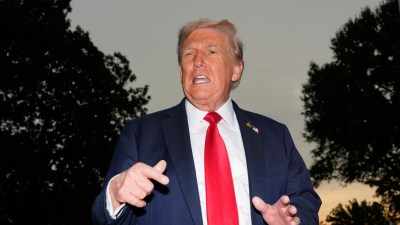Economic Survey projects India’s GDP growth to slow down to 6.5% in FY 2024: Highlights
The Economic Survey, however, has listed risks and challenges from widening current account deficit (CAD) amid elevated commodity prices, likelihood of further rate increases in policy rates by the US Federal Reserve, and the challenge of the depreciating rupee.
 Union Finance Minister Nirmala Sitharaman speaks in the Lok Sabha on the first day of Budget Session of Parliament. (PTI)
Union Finance Minister Nirmala Sitharaman speaks in the Lok Sabha on the first day of Budget Session of Parliament. (PTI) Union Finance Minister Nirmala Sitharaman Tuesday tabled the pre-Budget Economic Survey 2022-23 in Parliament after President Droupadi Murmu’s address to the joint sitting of the two Houses.
The Economic Survey was prepared by the Economic Division of the Department of Economic Affairs in the Ministry of Finance under the supervision of Chief Economic Adviser V Anantha Nageswaran. It gives insights into the state of the economy and various indicators in the current financial year 2022-23 (April-March) and the outlook for the next year.
The first economic survey reportedly was presented in 1950-51, when it used to be a part of the Budget. In the 1960s, it was separated from the Budget.
Here are the key highlights from the Economic Survey:
🔴 India’s economic growth is projected to slow to 6.5 per cent in the fiscal year starting April, but the country will remain the fastest growing major economy in the world. This gross domestic product (GDP) growth projection compares with an estimated 7 per cent expansion in current fiscal year (April 2022 to March 2023) and 8.7 per cent in 2021-22.
🔴 India is the world’s third largest economy in PPP (purchasing power parity) terms and fifth largest in terms of exchange rate. “Economy has nearly recouped what was lost, renewed what had paused, and re-energised what had slowed during the pandemic and since the conflict in Europe,” the survey says.
🔴 RBI’s projection of retail inflation at 6.8 per cent in the current fiscal is neither too high to deter private consumption, nor so low as to weaken inducement to invest. However, entrenched inflation may prolong the tightening cycle and therefore, borrowing costs may stay “higher for longer”. Retail inflation in India came down below 6 per cent in November after remaining above RBI’s upper tolerance level for 10 months since January 2022.
🔴 The survey also calls for close monitoring of the current account deficit (CAD), which may continue to widen because of elevated global commodity prices. The CAD widened to 4.4 per cent of the GDP in the quarter ending September, from 2.2 per cent of the GDP during the April-June period due to a higher trade gap, according to the latest Reserve Bank data.
“While commodity prices have retreated from record highs, they are still above pre-conflict levels. Strong domestic demand amidst high commodity prices will raise India’s total import bill and contribute to unfavourable developments in the current account balance. These may be exacerbated by plateauing export growth on account of slackening global demand. Should the current account deficit widen further, the currency may come under depreciation pressure,” the survey says.
🔴 The Indian rupee may remain under depreciation pressure on account of plateauing of exports and subsequent widening of the current account deficit. It says the “risks to the current account balance stem from multiple sources”.
🔴 Buoyancy in the real estate sector along with improved construction activities created jobs and facilitated the return of migrant workers to cities. This assumes significance in view of loss of jobs due to lockdown restrictions amid different waves of pandemic since March 2020.
🔴 Credit growth is likely to be brisk for MSMEs in FY 2023-24, provided inflation remains benign and cost of credit is low. Micro, small and medium enterprises witnessed a credit growth of about 31 per cent in January-November 2022.
🔴 Capital expenditure has started pushing private investment and the Budget target of Rs 7.5 lakh crore for the current financial year is likely to be met. The capital expenditure (capex) of the central government which increased by 63.4 per cent year-on-year in the first eight months of FY23 was another growth driver of the Indian economy, crowding in the private capex since the January-March quarter of 2022.
🔴 Foreign direct investment (FDI) is expected to rebound in the coming months on account of India’s high economic growth, and steps to further improve the business environment of India. The rise in global uncertainty in the wake of the Russia-Ukraine conflict, FDI equity inflows in the manufacturing sector in the first half of the current fiscal (April-September) fell below its corresponding level in the first half of 2021-22.
🔴 Housing prices have started to firm up after a two-year Covid lull and unsold inventories have declined on rise in demand. The survey anticipates a decline in prices on the back of a cut in import duties on many construction materials.
🔴 The country’s civil aviation sector has “great potential” owing to growing demand from the middle class, higher disposable incomes and favourable demographics, while air travel has rebounded with the lifting of the pandemic-related curbs.
🔴 The agriculture sector has performed well but it needs “re-orientation” in the backdrop of certain challenges like adverse impacts of climate change, rising input cost, etc. The other challenges are fragmented landholdings, sub-optimal farm mechanisation, low productivity, disguised unemployment, and rising input costs.
🔴 Gross tax revenues have touched 65 per cent of the Budget estimates at Rs 17.81 lakh crore during the first eight months of the current fiscal till November, propelled by corporate and personal income tax mop-up. “Substantial reforms” in India’s taxation ecosystem post-2014 and policy reforms have removed the distortionary incentives from the economy.
With inputs from PTI



- 01
- 02
- 03
- 04
- 05



























